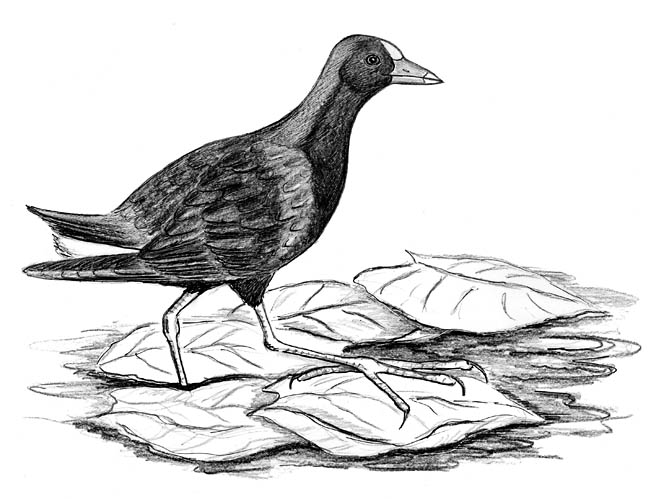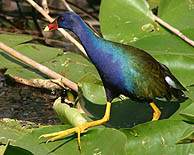
Dear Bird Folks,
This morning my little sister called us to the window because she saw an unusual bird in our yard. Because the bird was purple I first thought it was some kind of giant grackle, but after getting a better look I knew it definitely wasn’t a grackle. It was a Purple Gallinule. The book says it’s not found around here, but here’s a photo to prove it (sorry that it’s a little fuzzy). What is this bird doing in my yard?
– Parker, Grade 4, Eastham, MA

Holy cow, Parker,
That’s a Purple Gallinule all right. Fuzzy photo or not, it’s hard to mistake that bird for anything else, except maybe a “giant grackle.” You are pretty smart. You must have a good fourth grade teacher. Do you know how many Purple Gallinules I had seen by the time I was in the fourth grade? Zero. That’s how many. And I’ll bet 95% of the people reading this have yet to see a single one of these birds, and many of them are way, way past the fourth grade. I spent a week birding in Florida this winter and never saw a gallinule, and that’s where they live. (Of course, spending eight hours a day riding Space Mountain didn’t help.) Maybe the next time I go birding in Florida I should invite you and your sister to come along. You two could look for gallinules and call me when you find one. I’ll be waiting in line at Space Mountain.
You are so right, Parker. Purple Gallinules should not be in Eastham, or anywhere near Cape Cod. They are birds of the Deep South, rarely getting much further north than South Carolina. However, they are known vagrants. Being a “vagrant” in this case does not mean they are hobos, panhandling their way around the country. It means they sometimes end up far from their normal range. In this case, a gallinule made it all the way to Eastham where it went unnoticed until it was spotted by your keen-eyed little sister. Nice job, sis.
It’s amazing to me that gallinules are often found far from their normal range. They are in the rail family, and like most rails they stink at flying. A gallinule’s flight is slow and feeble. It flies with its legs hanging down, sometimes dragging them across the surrounding vegetation, looking like it hates every second it has to be in the air.
What gallinules lack in flying skills they make up for with other abilities. For one thing they can almost walk on water. Gallinules have crazy long toes that allow them walk on top of floating pondweeds or lily pads. BTW, because of their long toes they are one of the few birds that can actually palm a basketball, which really impresses their non-gallinule friends and scouts from the Boston Celtics. They are also good swimmers and can dive, too. If there is trouble, they have the ability to become completely submerged. They may remain underwater for quite a while, with only the tip of their beak poking out of the water, like a tiny submarine, with very long toes.
While the title of “purple” fits this gallinule, it is hardly its only color. The tail is white, the legs and feet are bright yellow and the body is a gaudy combination of purple, blue and green, making the bird look like it’s wearing a bad disco outfit. It also has a power blue forehead and a glowing red beak, with a yellow tip. Even its eyes are bright red, probably from staying out too late at the disco.
Gallinules are water-loving birds and rarely found away from it. They spend their day walking along the water’s edge picking up seeds, fruit, aquatic insects, and tiny frogs. They like water so much that they even build their nests on top of it. Typically, a gallinule’s nest is found in the middle of floating vegetation or tethered to a reed stalk just above the water. Building a nest on top of water offers the birds protection from many terrestrial predators. On the down side, their homes are notorious for having damp basements, which hurts the resale value.
After the eggs have been laid, both adults take turns incubating. Gallinules are noted for a having cute little ritual when they exchange places on the nest. The returning bird will offer the sitting bird a small gift, in the form of a piece of grass or a tiny leaf. If the sitting bird accepts the gift, it will leave the nest and its partner will take over the nest duties. Oddly, it seems birds have to pay for the privilege of babysitting. (What? Babysitting is a privilege? I don’t think so.) Only a few days after hatching, the baby gallinules are off swimming with their parents and will never return to the nest again.
Thanks for sharing your unusual sighting, Parker. I don’t know how long your gallinule will stay around here, or even how it ended up in Eastham in the first place. It’s a long way out of its normal range, especially for a bird that appears to have such poor flying skills. Perhaps it’s here for a wedding or it has arrived early for Eastham’s famous Windmill Weekend. I don’t blame it for that. I like Windmill Weekend. Although, it’s not as fun as Space Mountain, it’s pretty close.